KATHLEEN MCGURL lives near the sea in Bournemouth, UK, with her husband and elderly tabby cat. She has two sons who are now grown-up and have left home. She began her writing career creating short stories, and sold dozens to women’s magazines in the UK and Australia. Then she got side-tracked onto family history research – which led eventually to writing novels with genealogy themes. She has always been fascinated by the past, and the ways in which the past can influence the present, and enjoys exploring these links in her novels.
You can find out more at her website: http://kathleenmcgurl.com/, or follow her on Twitter: @KathMcGurl, Instagram: @KathleenMcGurl or Facebook.
HQ
An imprint of HarperCollinsPublishers Ltd.
1 London Bridge Street
London SE1 9GF
First published in Great Britain by HQ in 2019
Copyright © Kathleen McGurl 2019
Kathleen McGurl asserts the moral right to be identified as the author of this work.
A catalogue record for this book is available from the British Library.
This novel is entirely a work of fiction. The names, characters and incidents portrayed in it are the work of the author’s imagination. Any resemblance to actual persons, living or dead, events or localities is entirely coincidental.
All rights reserved under International and Pan-American Copyright Conventions. By payment of the required fees, you have been granted the non-exclusive, non-transferable right to access and read the text of this e-book on-screen. No part of this text may be reproduced, transmitted, downloaded, decompiled, reverse engineered, or stored in or introduced into any information storage and retrieval system, in any form or by any means, whether electronic or mechanical, now known or hereinafter invented, without the express written permission of HarperCollins.
E-book Edition © March 2019 ISBN: 9780008236991
Version: 2019-01-11
If you were educated in Ireland you’ll probably know all this already, in which case feel free to skip this section. Everyone else – please read on. I hope this will help provide some context for the novel. I’ll keep it as short as possible!
By the early twentieth century, Ireland had been ruled by England since Norman times. Over the years there had been various uprisings: notably Wolfe Tone’s United Irishmen rebellion of 1798. In response to this, the British Parliament passed the Acts of Union in 1800, formalising Ireland’s status as part of the United Kingdom of Great Britain and Ireland.
Many Irish were still unhappy under British rule. Harsh penal laws against Catholics and the aftermath of the Great Famine of the 1840s led to ever greater hostility against English landlords. In the late 1800s and early 1900s there was much discussion in parliament about the possibility of ‘Home Rule’ for Ireland. By 1914 a Government of Ireland bill was making its way through the British parliament system when the First World War broke out. It was put on hold.
But Irish nationalists weren’t prepared to wait for the end of the war for discussion to resume. At Easter 1916 various Irish nationalist forces combined in an uprising, taking control of parts of Dublin. The Proclamation of the Republic was read out from the steps of the General Post Office, declaring Ireland’s independence. British troops soon quashed the uprising, and most of its leaders were executed.
In the parliamentary elections of 1918 just after the end of the war, Ireland’s primary nationalist party Sinn Fein won a large majority of the Irish seats in parliament. However, they refused to swear the required oath of allegiance to the King, and instead set up the first Dáil Éireann (Irish Council), declaring Ireland to be an independent nation. Thus, Ireland slid into war against Britain. (One Sinn Fein MP was Constance Markievicz, the first woman to be elected to the UK Parliament. She was in jail at the time, for her part in the 1916 uprising. Constance was also the founder of the Fianna Éireann, ‘Warriors of Ireland’, a kind of military boy scouts, whose alumni went on to join the Republican army.)
In the cities, British troops kept control but in provincial areas it was the paramilitary police force – the Royal Irish Constabulary – that was left fighting against the nationalist Irish Volunteers. The RIC was reinforced by the undisciplined Black and Tans, named for their mismatched ex-army and police uniforms.










